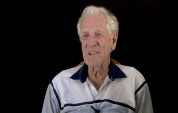3:33 | The USS Dorsey, a destroyer/minesweeper, had a number of weapons to protect itself. Roy Scribner was a loader on one of the 20mm guns which was primarily an anti-aircraft weapon. The 40mm gun at the stern was the best protection they had against kamikazes, which were a constant threat. They had already taken out three of the ten ships in his group. (This interview made possible with the support of THOMAS J. DOUGLAS, USAF.)
Keywords : Roy Scribner USS Dorsey (DD-117/DMS-1) minesweeper Lingayen Gulf kamikaze 40 mm gun 20 mm gun 3-inch gun Japanese

Roy Scribner was fifteen years old when the attack on Pearl Harbor shook the nation. He enlisted in the Navy as soon as he could, following his brother into that service and also in honor of a boy from his hometown who died on the USS Arizona. (This interview made possible with the support of THOMAS J. DOUGLAS, USAF.)
The physical training in Navy boot camp was no problem for Roy Scribner, who played football in school. He was sent to radio operators school at Texas A&M and then he joined the crew of the USS Dorsey, a minesweeper converted from a World War I era destroyer. (This interview made possible with the support of THOMAS J. DOUGLAS, USAF.)
Roy Scribner sailed under the Golden Gate bridge in September of 1944 on his way to join the fray. The radioman was also a loader on one of the ship's 20mm guns. The USS Dorsey, a minesweeper, was also armed with depth charges to engage with submarines. (This interview made possible with the support of THOMAS J. DOUGLAS, USAF.)
The hazing that Roy Scribner got the first time he crossed the equator included the eating of a bitter pudding that came with an unusual health benefit. He was on a minesweeper on the way to the Philippines and, once there, the ship became a target for kamikazes. (This interview made possible with the support of THOMAS J. DOUGLAS, USAF.)
Roy Scribner's first action was at Lingayen Gulf and the day he arrived there on a minesweeper, the kamikazes began attacking. The gun crews had to sleep at their guns when the danger was ongoing, which could also mean nothing to eat but sandwiches for days. (This interview made possible with the support of THOMAS J. DOUGLAS, USAF.)
While getting supplies in Leyte, Roy Scribner remembers how the locals would paddle up in canoes to trade eggs to the sailors. While there, someone smuggled something aboard that really shouldn't be there, a mascot for the ship. The minesweeper left there and assembled with other ships to prepare for the Iwo Jima landing. (This interview made possible with the support of THOMAS J. DOUGLAS, USAF.)
It was cold and raining as huge ships pounded the tiny island of Iwo Jima ahead of the landing. Roy Scribner was on the USS Dorsey, a minesweeper. In his diary, he sketched the raising of the flag as well as noting the staggering casualty figures. When the ship broke away from the battle for refueling, the crew nearly met with disaster during the routine task. (This interview made possible with the support of THOMAS J. DOUGLAS, USAF.)
At Okinawa, the USS Dorsey received it's only kamikaze hit after a long streak of near misses. Roy Scribner describes the attack from his vantage point as a gun loader. Fortunately, the damage was not severe and they steamed to Pearl Harbor for repairs. On their way there, they received some bad news from back home. (This interview made possible with the support of THOMAS J. DOUGLAS, USAF.)
As the USS Dorsey approached Pearl Harbor for repairs, the pet dog smuggled on board got very excited. He was about tired of Navy life. Almost as soon as the minesweeper returned to action, the war ended. Roy Scribner tells the story of the typhoon that nearly put them under off the coast of Japan. (This interview made possible with the support of THOMAS J. DOUGLAS, USAF.)
The going home banner was strung aloft after victory in the Pacific was won, but before the USS Dorsey left the dock, a typhoon struck and grounded the ship. Mother Nature had done what the Japanese could not. Roy Scribner was given the task of securing the sensitive communications material. (This interview made possible with the support of THOMAS J. DOUGLAS, USAF.)
Before Roy Scribner headed home from the Pacific, he had to watch his ship, the USS Dorsey demolished and scuttled after being slammed by a typhoon. Back home, he was sent to Camp Shoemaker, a place he knew very well. (This interview made possible with the support of THOMAS J. DOUGLAS, USAF.)